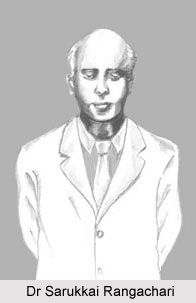 Dr Sarukkai Rangachari was a well-known physician of Madras Presidency. He was born in April 1882 in an affluent Ayyangar family. His father Raja Srinivasa Ayyangar was an Executive Engineer of the Madras Provincial Government. So, he was expecting his son to follow his profession. But S Rangachari had something else in mind and dreamt to be a doctor.
Dr Sarukkai Rangachari was a well-known physician of Madras Presidency. He was born in April 1882 in an affluent Ayyangar family. His father Raja Srinivasa Ayyangar was an Executive Engineer of the Madras Provincial Government. So, he was expecting his son to follow his profession. But S Rangachari had something else in mind and dreamt to be a doctor.
Sarukkai Rangachari belonged to the Tanjavur district. He got his early education done in Kumbakonam, which was then popularly called `the Cambridge of South India`. He moved to Madras like other rich young men of the district of those days. There, he joined the famous Madras Christian College, which was situated just opposite to the Madras High Court. He passed out with flying colours and then declared to his family that he will study only medicine.
In some corner of the heart, Sarukkai Rangachari had the desire to go to England for further studies, which was not affordable for his family. Moreover, at that time the orthodox Brahmins were forbidden from crossing the high seas. But in spite of all those opposition, he became a well-known doctor very soon. He was appointed in the Madras Provincial Medical Services as Assistant Surgeon. He worked in several towns in the Madras Presidency like Negapatam (now Nagapattinam), Tanjore (now Tanjavur) Kumbakonam and many others.
Dr Sarukkai Rangachari was transferred to the Madras City in 1919 and he joined the well-known General Hospital in Park Town. Very soon, he became reputed all over the Presidency. People started believing that he could heal any disease and nothing was beyond his capability. He used to serve the people at any hours of the day with a pleasing smile and was on the move at every moment. He even bought a Rolls Royce motorcar to visit his patients and to go the hospital. Thereafter Rangachari bought a light aircraft to enable him to visit patients in several parts of South India, which was a rare case at that period.
Dr. Sarukkai Rangachari believed as much on human psychology as on his rare medical skills and brilliance. He did not support the theory that a patient coming to a doctor should be immediately prescribed half a dozen medicines and expensive injections. He used to cure many complex diseases by simply using human psychology instead of medicines.
Dr. Rangachari was a down- to -earth person and never bothered about the status and wealth of the man or woman who came to him for relief. He treated the rich and poor alike and many times he paid for the day-to-day expenses of poor patients who came to him. He used to train his three assistants by providing them the benefit of his knowledge, skills and experience, who later rose to higher positions in the world of medicine in Madras. These students were Lt Col Dr C R Krishnaswami, Dr. R. Sankaran, and Dr. V. Rama Ayyangar.
Dr. Sarukkai Rangachari had no children. He was attacked by acute typhoid for which in those days there was no proper treatment. He passed away in 1934 at the age of 52 years. His early death was a severe loss to the medical profession of Madras and also to the suffering humanity in the Southern part of the country. To commemorate his contributions towards the suffering humanity, a life-size statue of him was erected by the general people in front of the General Hospital. The statue has a tablet which contains the following lines as unforgettable tribute to the great medical practitioner of Madras "…and rare medical skills and boundless humanity".



















